Trampolines have become a popular addition to many households, offering hours of outdoor fun and entertainment for both children and adults. Regarding choosing a trampoline, two primary shapes dominate the market: square and circular.
Each shape offers unique advantages and considerations, and deciding between them is important for potential buyers.
Square trampolines are known for their controlled bounce, higher bounce heights, and enhanced control for tricks and gymnastics. The square shape provides a consistent tension distribution, ensuring an even and predictable jumping experience across the surface.
On the other hand, circular trampolines offer responsive bounces, lateral movement, and centralized tension distribution. They are often favored for their suitability for recreational jumping and the ability to accommodate multiple users simultaneously.
In this comparison, we will explore and analyze various aspects of square and circular trampolines, including design and shape, safety, size, and space utilization, bounce quality and performance, durability and maintenance, price range and affordability, to help you make an informed decision and find the trampoline that best suits your needs and preferences.
Square vs circle trampoline: Square trampolines offer controlled bounce and precise movements, while circular trampolines provide dynamic jumps and spacious bouncing areas. Choose based on your preferences and space availability.
Introduction of the Square Trampoline
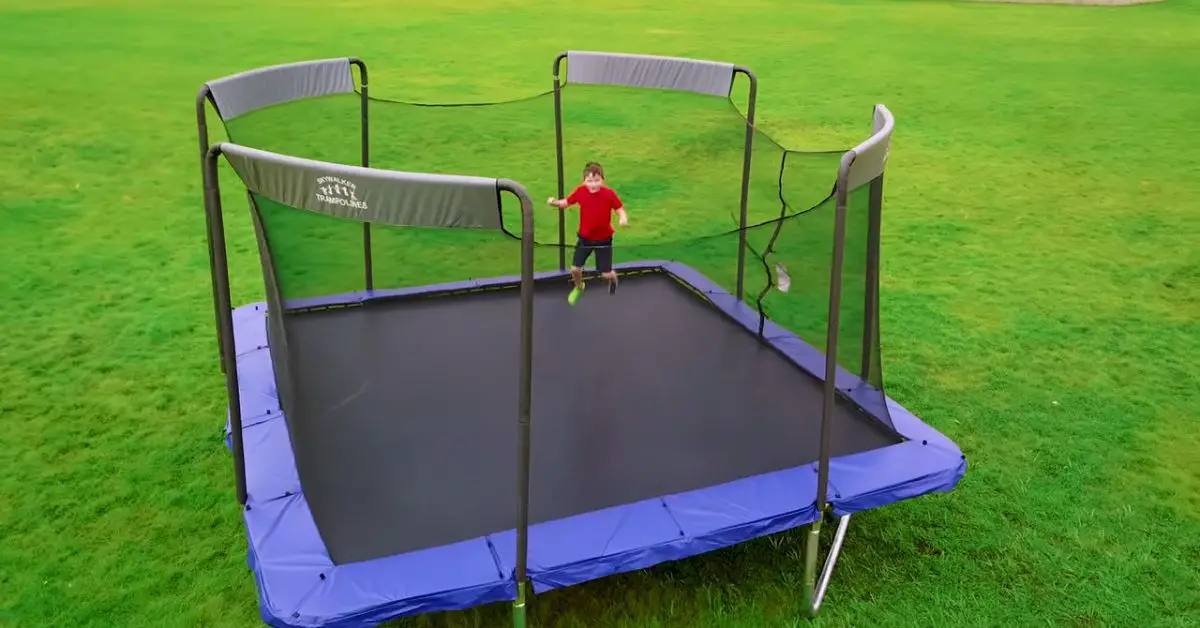
Square trampolines are one of the popular shapes available in the market. They have a symmetrical square frame and provide a spacious jumping area. The square design allows for a consistent bounce throughout the surface, providing a more controlled and predictable jumping experience.
Gymnasts often prefer them or those practicing specific jumping routines due to their shape and performance characteristics.
Introduction of the circular trampoline:
Circular trampolines are another common type found in backyards and recreational areas. They feature a round frame and jumping surface. The circular shape provides a more even distribution of the springs and tension, resulting in a balanced bounce across the entire surface.
This shape is popular among recreational users and families as it accommodates multiple users and allows for various jumping styles and activities.
Square vs Circle Trampoline: A Comprehensive Comparison
When comparing square and circular trampolines, there are several factors to consider. Let’s explore the differences between these two shapes
- Design and Shape:
- Safety
- Size and Space Utilization
- Bounce Quality and Performance
- Durability and Maintenance
- Price Range and Affordability:
Design and Shape:
The design and shape of a trampoline play a crucial role in determining its functionality, safety, and overall user experience. When comparing the square and circular trampolines, it is important to consider each shape’s specific attributes and benefits.
Square Trampoline
Description and Features
Square trampolines are popular among trampoline enthusiasts due to their unique design and features. They are characterized by their four-sided shape with equal sides, forming a perfect square. Square trampolines are available in various sizes, catering to different space requirements and user preferences.
The frame of a square trampoline is typically made of sturdy materials such as galvanized steel, ensuring durability and stability during use. The jumping mat is securely attached to the frame using springs or alternative tensioning systems.
Advantages of the Square Shape
The square shape of the trampoline offers several advantages over other shapes:
Maximum Jumping Area:
Square trampolines provide a larger jumping area than round or oval trampolines of the same dimensions. The squared-off corners allow users to utilize the full space of the trampoline, providing ample room for jumps, flips, and tricks.
Bounce Quality:
Square trampolines are known for their consistent and predictable bounce. The even tension distribution of the springs across the square shape ensures a more balanced bounce, enabling users to achieve greater height and control during jumps.
Gymnastic Maneuvers:
The square shape of the trampoline makes it an ideal choice for gymnastic maneuvers and tricks. The straight edges and corners provide reference points for performers, helping them maintain orientation and execute precise movements.
Unique Design Elements
Square trampolines often incorporate additional design elements that enhance safety and user experience:
Safety Enclosures:
Many square trampolines come equipped with safety enclosures with a netting system surrounding the entire jumping area. This feature prevents users from accidentally bouncing off the trampoline, reducing the risk of injuries.
Reinforced Frames:
Square trampolines are designed with reinforced frames to withstand the higher impact forces generated by jumps and tricks. The robust frame construction ensures durability and longevity, even with frequent and intense use.
Circular Trampoline
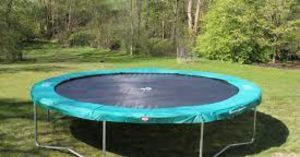
Description and Features
Circular trampolines are another popular choice for both recreational and professional use. They feature a circular shape, resembling a traditional round trampoline.
Circular trampolines come in various sizes, accommodating different space requirements and user preferences.
The frame is typically made of durable materials such as galvanized steel, ensuring stability and longevity. The jumping mat is securely attached to the frame using springs or alternative tensioning systems, similar to square trampolines.
Advantages of the Circular Shape
The circular shape of the trampoline offers several advantages:
Centralized Bouncing Area:
Circular trampolines have a centralized bouncing area, making it easier for users to maintain their balance and control. This design minimizes the risk of users unintentionally drifting toward the edges, reducing the likelihood of accidents.
Access from Any Point:
Circular trampolines allow users to enter and exit from any point around the perimeter. This convenience eliminates the need to locate specific entry points, offering more flexibility during use.
Safety Accessories:
Circular trampolines often have a wider variety of safety accessories available, such as specially designed safety enclosures and padding for the springs and frame. These accessories provide added protection and help minimize the risk of injuries.
Unique Design Elements
Circular trampolines incorporate specific design elements to enhance safety and user experience:
Wider Range of Sizes:
Circular trampolines are available in a wider range of sizes, catering to different space constraints and user requirements. This flexibility allows users to choose the size that best suits their available area and desired activity level.
Weather Resistance:
Many circular trampolines are designed with weather-resistant materials, such as UV-protected jumping mats and rust-resistant frames. These features make them suitable for outdoor use, with increased durability against environmental elements.
Safety
Ensuring trampoline users’ safety is paramount, regardless of the trampoline shape. Several aspects should be considered when comparing the safety features and considerations of square and circular trampolines.
Square Trampoline
Safety Features and Considerations:
When it comes to safety, square trampolines offer specific features and considerations to ensure a secure jumping experience:
Frame Construction:
Square trampolines are typically built with a sturdy frame made of galvanized steel or other durable materials. This construction provides stability and reduces the risk of the trampoline tipping over during use.
Even Bounce Distribution:
Square trampolines are designed to distribute tension evenly across the jumping surface. This feature enhances stability, minimizing the chances of users being propelled toward the edges or experiencing uneven bouncing.
Weight Limit and Load Capacity:
Square trampolines come with specified weight limits and load capacities. It is crucial to adhere to these guidelines to ensure the trampoline’s structural integrity and prevent accidents or damage.
Durability and Weather Resistance:
High-quality square trampolines, featuring weather-resistant materials, are often built to withstand outdoor conditions. This durability ensures the trampoline can withstand exposure to elements such as sun, rain, and wind without compromising safety.
Safety Enclosure Options:
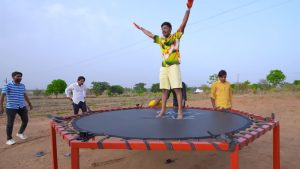
To enhance safety further, square trampolines offer various safety enclosure options:
Netting Systems:
Many square trampolines come with safety enclosures comprising tightly woven netting systems. These enclosures surround the entire jumping area, preventing users from accidentally bouncing off the trampoline and reducing the risk of injuries.
Zippered Entry Points:
Square trampolines often incorporate zippered entry points in their safety enclosures. These entry points allow users to enter and exit the trampoline while ensuring that they remain securely enclosed during jumping sessions.
Circular Trampoline
Safety Features and Considerations:
Circular trampolines prioritize safety through specific features and considerations:
Frame Construction:
Like square trampolines, circular trampolines feature sturdy frames made of materials like galvanized steel. This construction ensures stability during use and minimizes the risk of the trampoline tipping over.
Even Bounce Distribution:
Circular trampolines are designed to distribute tension evenly across the jumping surface, resulting in a balanced and controlled bounce. This feature reduces the likelihood of users being propelled toward the edges or experiencing uneven bouncing.
Weight Limit and Load Capacity:
Circular trampolines have specified weight limits and load capacities, which should be adhered to strictly for safety reasons. Exceeding these limits can compromise the trampoline’s stability and increase the risk of accidents.
Durability and Weather Resistance:
High-quality circular trampolines are often constructed using weather-resistant materials. This durability allows them to withstand outdoor elements, ensuring they remain safe and functional over time.
Safety Enclosure Options:
Circular trampolines also offer various safety enclosure options to enhance user safety:
Netting Systems:
Many circular trampolines are equipped with safety enclosures featuring high-quality netting systems. These enclosures surround the entire jumping area, preventing users from accidentally bouncing off the trampoline and minimizing the risk of injuries.
Padded Springs and Frame:
Some circular trampolines have additional safety features, such as spring and frame padding. This padding provides an extra layer of protection, reducing the risk of users coming into contact with the springs or frame while jumping.
Size and Space Utilization
A trampoline’s size and space utilization are important factors to consider when choosing between a square and circular design. The available sizes and dimensions and how well the trampoline fits into different backyard shapes can significantly impact its usability and integration into outdoor spaces.
Square Trampoline
Available Sizes and Dimensions:
Square trampolines are available in various sizes and dimensions to accommodate different space requirements and user preferences. Common sizes include 8 feet by 8 feet, 10 feet by 10 feet, and 12 feet by 12 feet, although larger sizes are also available. The dimensions are consistent on all sides, creating a perfect square shape.
Space Utilization Benefits:
Square trampolines offer several benefits when it comes to space utilization:
Maximum Jumping Area:
The square shape of the trampoline allows for efficient use of space. Square trampolines provide a larger jumping area within the given dimensions than other shapes. This means more room for jumps, tricks, and activities, allowing users to fully enjoy their trampoline experience.
Corner-to-Corner Utilization:
Square trampolines make utilizing the entire jumping surface, including the corners, easier. The straight sides and sharp corners enable users to perform jumps and maneuvers in all trampoline areas, maximizing the available space.
Fit for Various Backyard Shapes:
Square trampolines are versatile when it comes to fitting different backyard shapes:
Straight Edges:
The straight edges of a square trampoline make it well-suited for yards with straight boundaries or against walls. This shape can be easily positioned against fences or structures, allowing for efficient use of space without leaving unused gaps.
Multiple Trampoline Setup:
Square trampolines can be arranged side by side or in a grid formation for those with larger yards or desiring multiple trampolines. This setup maximizes space utilization and provides options for simultaneous jumping activities or designated areas for different age groups.
Circular Trampoline
Available Sizes and Dimensions:
Circular trampolines come in various sizes and dimensions to accommodate different space requirements and user preferences. Common sizes include 8 feet in diameter, 10 feet in diameter, and 12 feet in diameter, although larger sizes are also available.
The diameter represents the measurement from one side of the trampoline, passing through the center to the opposite side.
Space Utilization Benefits:
Circular trampolines offer specific benefits in terms of space utilization:
Centralized Bouncing Area:
The circular shape of the trampoline provides a centralized bouncing area. This means that users are naturally directed towards the center, reducing the risk of accidentally bouncing off the trampoline or drifting towards the edges. It allows for controlled and focused jumping activities.
Compact Footprint:
Circular trampolines have a compact footprint compared to square trampolines of the same diameter. This makes them suitable for smaller yards or areas with limited space, providing a fun and safe jumping experience without occupying excessive space.
Fit for Various Backyard Shapes:
Circular trampolines are adaptable to various backyard shapes:
Rounded Boundaries:
The shape of circular trampolines complements yards with rounded boundaries or curved landscapes. They seamlessly blend into the environment and create a visually pleasing focal point.
Central Placement:
Circular trampolines can be positioned centrally in the yard, allowing for equal access from all sides. This positioning enhances the aesthetics of the space and ensures an even distribution of the trampoline’s visual impact.
Bounce Quality and Performance
A trampoline’s bounce quality and performance are crucial factors that determine the overall jumping experience. When comparing the bounce characteristics and performance of square and circular trampolines, several key aspects should be considered.
Square Trampoline
Bounce Characteristics and Performance:
Square trampolines offer unique bounce characteristics and performance features that contribute to an exciting jumping experience:
Controlled Bounce:
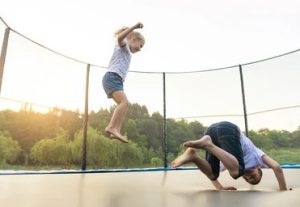
Square trampolines provide a controlled and responsive bounce. The even tension distribution across the square shape allows users to achieve consistent and predictable jumps.
This control is particularly beneficial for performing tricks and maneuvers, as users can anticipate and adjust their movements accordingly.
Higher Bounce Height:
Square trampolines are known to provide higher bounce height compared to other trampoline shapes. The design of the springs and the tension distribution across the jumping mat contribute to the increased vertical lift, allowing users to reach impressive heights during jumps.
Consistency of Bounce Across the Surface:
Square trampolines offer consistent bounce characteristics across the entire surface, ensuring a uniform jumping experience:
Balanced Tension:
The design of square trampolines ensures an even distribution of tension among the springs and jumping mats. This balanced tension minimizes variations in bounce intensity across the surface, providing a consistent bounce regardless of the user’s position on the trampoline.
Stable Landing Zones:
The squared-off corners of a square trampoline create clear reference points for landing. Users can accurately gauge their landing positions and adjust their movements accordingly, resulting in a smoother and more controlled landing experience.
User Experience and Feedback:
Users of square trampolines often report positive experiences and provide favorable feedback regarding the bounce quality and performance:
Enhanced Control:
Many users appreciate the heightened control they experience on square trampolines. The predictable bounce and consistent tension distribution allow them to execute tricks, flips, and other aerial maneuvers with greater precision and confidence.
Versatility for Tricks and Gymnastics:
Square trampolines are particularly favored by gymnasts and individuals interested in performing advanced tricks. The square shape provides clear reference points and optimal surface area for executing complex routines and sequences.
Circular Trampoline
Bounce Characteristics and Performance:
Circular trampolines offer unique bounce characteristics and performance features that contribute to an enjoyable jumping experience:
Responsive Bounce:
Circular trampolines provide a responsive and energetic bounce. The tension distribution across the springs and jumping mat promotes an upward lift that propels users into the air, creating a dynamic jumping experience.
Lateral Movement:
Circular trampolines allow for natural lateral movement during jumps. Users can easily transition between different trampoline areas, creating a sense of flow and freedom of movement.
Consistency of Bounce Across the Surface:
Circular trampolines strive to maintain consistent bounce characteristics across the entire jumping surface:
Centralized Tension Distribution:
Circular trampolines distribute tension evenly across the springs and jumping mat, resulting in a balanced bounce experience. Users can expect similar bounce intensity and responsiveness regardless of their position on the trampoline.
Reinforced Center:
Circular trampolines often have reinforced centers, ensuring that the area directly above the springs offers a consistent and supportive bounce. This reinforcement helps maintain the trampoline’s performance and extends its longevity.
User Experience and Feedback:
Users of circular trampolines express positive experiences and provide favorable feedback regarding the bounce quality and performance:
Playful and Engaging:
Circular trampolines offer a playful and engaging jumping experience. The energetic bounce and responsive surface encourage users to explore various jumping styles and enjoy dynamic movements.
Suitable for Group Activities:
Circular trampolines are well-suited for group activities and social interaction. The centralized bouncing area facilitates shared experiences, enabling multiple users to jump together and engage in interactive games.
Durability and Maintenance
When investing in a trampoline, it is essential to consider its durability and maintenance requirements. A durable trampoline is built to withstand regular use, various weather conditions, and the test of time.
Understanding the material and construction quality, longevity, and maintenance considerations can help ensure a long-lasting and reliable trampoline experience. Let’s explore these factors for both square and circular trampolines:
Square Trampoline
Material and Construction Quality:
Square trampolines are designed and constructed using high-quality materials to ensure durability and longevity. Key aspects of their material and construction quality include:
Galvanized Steel Frame:
Square trampolines often feature frames made of galvanized steel, which is known for its strength and resistance to rust and corrosion. This robust frame material provides a sturdy foundation and contributes to the trampoline’s overall durability.
Reinforced Joints:
Square trampolines are constructed with reinforced joints, typically using welding or strong connectors. These reinforced joints enhance the structural integrity of the trampoline, reducing the risk of breakage or weakening over time.
UV-Resistant Jumping Mat:
The jumping mat of square trampolines is usually made of UV-resistant polypropylene material. This material is designed to withstand prolonged exposure to sunlight without deteriorating or losing its elasticity, ensuring the trampoline’s longevity.
Longevity and Resistance to Wear:
Square trampolines are known for their durability and resistance to wear, offering long-lasting performance:
Sturdy Frame:
The galvanized steel frame used in square trampolines provides excellent resistance against bending, warping, or structural damage. This durability allows the trampoline to withstand regular use and external factors, such as weather conditions, without compromising its integrity.
Reinforced Springs:
Square trampolines typically feature strong and durable springs that can withstand repeated bouncing and stretching. These springs are designed to maintain their tension and elasticity over an extended period, ensuring consistent bounce performance and minimizing wear and tear.
UV Protection:
The UV-resistant jumping mat of square trampolines helps protect against fading, degradation, and weakening due to sun exposure. This UV protection prolongs the lifespan of the mat, allowing it to retain its flexibility and bounce quality over time.
Maintenance Requirements:
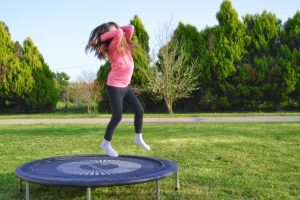
Square trampolines require regular maintenance to ensure their optimal performance and longevity:
Inspections:
Regularly inspect the frame, springs, and jumping mat for signs of damage, wear, or corrosion. Promptly address any issues to prevent further deterioration and ensure user safety.
Cleaning:
Keep the jumping mat and safety padding clean by periodically removing debris, dirt, and leaves. Use a soft brush or cloth with mild soap and water to clean the surface, avoiding harsh chemicals that could damage the material.
Weather Protection:
When not in use, cover the square trampoline with a weather-resistant cover to protect it from excessive sun exposure, rain, or snow. This helps prevent premature wear and fading of the materials.
Circular Trampoline
Material and Construction Quality:
Circular trampolines are also built using durable materials to ensure their longevity and performance:
Galvanized Steel Frame:
Similar to square trampolines, circular trampolines often feature galvanized steel frames that strengthen and resist rust and corrosion. This sturdy frame material forms a solid foundation for the trampoline.
Reinforced Joints:
Circular trampolines are designed with reinforced joints, ensuring stability and durability. These reinforced joints enhance the trampoline’s structural integrity and reduce the risk of wear and tear over time.
UV-Resistant Jumping Surface:
The jumping mat of circular trampolines is typically made of UV-resistant polypropylene material, similar to square trampolines. This UV protection helps prevent damage and fading caused by sun exposure, extending the trampoline’s lifespan.
Longevity and Resistance to Wear:
Circular trampolines are built to withstand regular use and maintain their performance over time:
Strong Frame:
The galvanized steel frame of circular trampolines provides durability and resistance to bending or warping. This strength allows the trampoline to withstand the forces exerted during bouncing and external factors, ensuring its long-term durability.
Robust Springs:
Circular trampolines have sturdy springs designed to withstand repetitive bouncing and stretching. These springs retain their tension and elasticity, providing consistent bounce performance and minimizing wear and tear.
UV Protection:
The UV-resistant jumping mat of circular trampolines helps protect against sun damage, maintaining the mat’s flexibility and bounce quality for an extended period. This UV protection contributes to the trampoline’s longevity.
Maintenance Requirements:
Circular trampolines also require regular maintenance to ensure optimal performance and longevity:
Periodic Inspections:
Regularly inspect the frame, springs, and jumping mat for any signs of damage or wear. Address any issues promptly to prevent further deterioration and maintain user safety.
Cleaning:
Clean the jumping mat and safety padding periodically by removing debris, dirt, and leaves. Use a soft brush or cloth with mild soap and water to gently clean the surface. Avoid using abrasive cleaners that could damage the material.
Weather Protection:
Cover the circular trampoline with a weather-resistant cover to protect it from sun exposure, rain, or snow when not in use. This protective cover helps preserve the trampoline’s materials and prevents premature wear and fading.
Price Range and Affordability:
When considering a trampoline purchase, the price range and affordability are important factors to consider. The cost of a trampoline can vary based on factors such as size, brand, materials, additional features, and overall quality.
Understanding the price range, value for money considerations, and any additional cost factors can help you make an informed decision regarding your budget and investment. Let’s explore these aspects for both square and circular trampolines:
Square Trampoline
Price Range and Options:
Square trampolines are available at a range of prices, offering options to suit different budgets and preferences. The price range for square trampolines typically depends on factors such as size, brand, materials used, and additional features.
Entry-Level:
Entry-level square trampolines, with smaller dimensions and basic features, generally fall in the lower price range. These trampolines suit those on a tight budget or those looking for a smaller trampoline for younger children.
Mid-Range:
Mid-range square trampolines, with moderate dimensions and additional features, are priced in the middle range. These trampolines often balance quality, size, and affordability, making them popular among many buyers.
High-End:
High-end square trampolines, with larger dimensions, premium materials, and advanced features, are typically priced at the higher end. These trampolines are designed for those seeking top-of-the-line quality, durability, and performance.
Value for Money Considerations:
When considering the value for money of square trampolines, several factors come into play:
Quality and Durability:
Square trampolines built with high-quality materials and sturdy construction offer better value for money in the long run. Investing in a trampoline that can withstand years of use without significant wear and tear ensures a better return on investment.
Safety Features:
Trampolines with built-in safety features, such as safety enclosures, padded frames, and reinforced joints, provide added value for money. These features contribute to users’ safer jumping experience and peace of mind.
Warranty and Customer Support:
Square trampolines that come with generous warranties and reliable customer support provide added value for money. A comprehensive warranty ensures protection against manufacturing defects, while responsive customer support can assist with any issues or concerns that may arise.
Additional Cost Factors:
In addition to the base price of a square trampoline, there are some additional cost factors to consider:
Accessories:
Square trampolines may require additional accessories such as ladders, anchor kits, or weather covers. These accessories add to the overall cost but can enhance the trampoline’s safety, convenience, and longevity.
Installation:
Professional installation may be recommended or required depending on the size and complexity of the square trampoline. The installation cost should be factored into the overall budget for purchasing a trampoline.
Circular Trampoline
Price Range and Options:
Circular trampolines also offer a range of prices to accommodate different budgets and preferences. The price range for circular trampolines depends on factors such as size, brand, materials, and additional features.
Entry-Level:
With smaller diameters and basic features, entry-level circular trampolines are generally more affordable. These trampolines are suitable for those with budget constraints or those looking for a compact option for younger jumpers.
Mid-Range:
Mid-range circular trampolines, with moderate diameters and additional features, fall in the middle price range. These trampolines offer a good balance between affordability and quality, appealing to a wide range of buyers.
High-End:
High-end circular trampolines, with larger diameters, premium materials, and advanced features, are typically priced at the higher end. These trampolines cater to buyers prioritizing top-notch quality, durability, and performance.
Value for Money Considerations:
Consider the following factors when assessing the value for money of circular trampolines:
Quality and Durability
Circular trampolines constructed with high-quality materials and solid craftsmanship offer better long-term value. Investing in a durable trampoline that can withstand regular use and various weather conditions ensures a worthwhile investment.
Safety Features:
Circular trampolines equipped with safety features like safety enclosures, padding, and sturdy frames provide added value. These features contribute to a safer jumping experience and increase the trampoline’s overall value.
Warranty and Customer Support:
Circular trampolines backed by generous warranties and reliable customer support offer added value for money. A comprehensive warranty protects against manufacturing defects, while accessible customer support ensures assistance with any concerns or queries.
Additional Cost Factors:
In addition to the base price, consider these additional cost factors associated with circular trampolines:
Accessories:
Circular trampolines may require accessories such as ladders, anchor kits, or weather covers, which can incur additional costs. These accessories contribute to the safety, convenience, and longevity of the trampoline.
Installation:
Professional installation may be recommended or necessary depending on the size and complexity of the circular trampoline. The installation cost should be factored into the overall budget for purchasing a trampoline.
User Preferences and Target Audience
When comparing user preferences and the target audience for Square and Circle Trampolines, it’s evident that each design appeals to different individuals based on their priorities and needs.
Square trampolines tend to attract those who value a distinct bouncing experience, seek a challenge through varying tension, or have ample space in rectangular areas.
This design suits families with larger outdoor spaces, trampoline enthusiasts seeking novelty, and individuals who enjoy experimenting with diverse jumping patterns.
On the other hand, Circle Trampolines cater to safety-conscious individuals who prioritize even tension and a consistent bounce, making them ideal for families with young children.
Moreover, the centered experience and compatibility with limited spaces make circle trampolines preferable for users with constrained outdoor areas or an aesthetic focus on blending into surroundings.
By understanding these distinctions, individuals can select the trampoline style that aligns best with their preferences and specific needs for an enjoyable and safe jumping experience.
Are square trampolines better than round?
A circular trampoline might look like it has more space for jumping, but a square trampoline gives you more. This is because there is more room from one corner to another. The square shape of the trampoline helps you jump better because it provides strong support in the middle.
FAQs:
Q.1 Which shape, square or circle, provides a better jumping experience?
Both shapes offer unique jumping experiences. Square trampolines provide controlled bounce and precise movements, ideal for gymnastics and tricks. Circular trampolines offer a dynamic bounce and spacious jumping area, perfect for recreational bouncing and family fun.
Q.2 Are square trampolines safer than circular trampolines?
Both square and circular trampolines can be safe when used properly and equipped with safety features like enclosures. Safety ultimately depends on factors such as user behavior, proper installation, and adherence to safety guidelines.
Q.3 Which shape is more suitable for small or irregularly shaped backyards?
Square trampolines are known for their space-efficient design and versatility in fitting various backyard shapes. They can make better use of available space, especially in smaller or irregularly shaped yards, compared to circular trampolines.
Q.4 Are square or circular trampolines more durable?
Durability depends on the quality of materials and construction. Both square and circular trampolines can be durable when made with high-quality materials. It’s essential to consider factors like frame strength, jumping mat quality, and weather resistance when assessing durability.
Q.5 Do square or circular trampolines have better bounce quality?
Square trampolines provide a controlled and consistent bounce, ideal for gymnasts and those who prefer precise movements. Circular trampolines offer a responsive and dynamic bounce, appealing to recreational users looking for a fun and comfortable jumping experience.
Conclusion:
In conclusion, when comparing square and circular trampolines, both shapes have their own unique advantages and considerations. The square trampoline offers a distinct design and shape, providing a larger jumping surface and better space utilization.
It fits well in various backyard shapes and offers consistent bounce across the surface. Safety features, such as enclosures, are readily available for square trampolines. However, the square shape may not provide a centralized bouncing area, which could affect the user experience.
On the other hand, circular trampolines have their own merits. They feature a unique design with rounded boundaries, which can enhance safety by directing users toward the center. Circular trampolines also provide a centralized bouncing area and offer space utilization benefits.
They have consistent bounce characteristics and user feedback is generally positive. However, circular trampolines may not fit as well in certain backyard shapes compared to square trampolines.
When considering durability and maintenance, both square and circular trampolines can be made with high-quality materials and construction. Their longevity and resistance to wear are similar, and maintenance requirements are generally manageable.
Regarding price and affordability, both shapes come in various price ranges and options. Factors such as size, brand, and additional features can affect the cost of both square and circular trampolines.
Ultimately, the choice between square and circular trampolines depends on individual preferences, backyard space, and specific requirements. Consider all the factors discussed to determine which shape is the right fit for you.
After reading this detailed guide about square and circle trampolines, we hope you will understand the topic well. If you have any questions, please feel free to leave a comment below!

